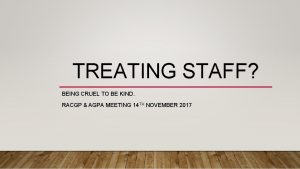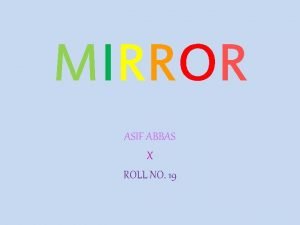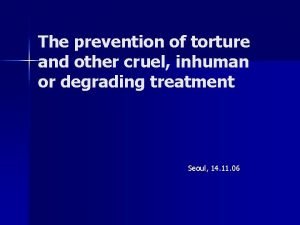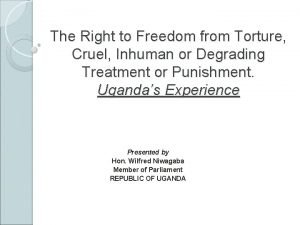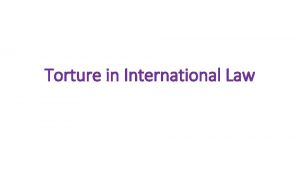On torture or Cruel Inhuman and Degrading Treatment








- Slides: 8

“On torture, or Cruel, Inhuman and Degrading Treatment” (Asad, 1997: 111 -133): Secrets for a Global “Good”

Euro-American use of force to promote their own moral standards does not make the ideas presented in article 5 universal, but their use of force does succeed in globalizing their own moral standards (Asad, 1997: 128).

According to polls conducted by The Coalition Provisional Authority, 63% of Iraqis supported the occupation before Abu Ghraib, but one month after Abu Ghraib only 9% of Iraqis still supported the occupation (Otterman, 2007: 190). A 1956 report for the CIA stated “the effects of isolation, anxiety, fatigue, lack of sleep, uncomfortable temperature, and chronic hunger produce disturbances of mood, attitudes, and behavior” and “these methods do, of course, constitute torture and physical coercion” (Otterman, 2007: 196). The Military Commissions Act of 2006 allows the use of waterboarding (Otterman, 2007: 186).

Pain is legal and accepted in certain situations including war, sports, and psychological experiments (Asad, 1997: 120).

Eliminati ng torture “is not simply a matter of eliminating particular cruelties, but of imposing an entire modern discourse of being human” (Asad, 1997: 127).

When liberal-democratic governments subject individuals to torture they tend to do so in secrecy (Asad, 1997: 120). The International Committee of the Red Cross (ICRC) were the first to cite abuses at Abu Ghraib. The next time the ICRC came to inspect Abu Ghraib they were restricted from seeing eight “high value” detainees (Otterman, 2007: 166 -167).

Joe Darby thought the misconduct at Abu Ghraib was wrong, “but there was no need for the public to know about it”; he was shocked to hear about the Abu Ghraib prison scandal on CNN because he had never intended on the photos being leaked to the press (Sharrock, 2010: 67). After seeing the explicit photos of detainees at Abu Ghraib, Joe Darby went to the Criminal Investigation Division (CID) to expose the incident (Sharrock, 2010: 66).

Works Cited Asad, Talal. “On Torture, or Cruel, inhuman and Degrading Treatment”. Human Rights, Culture and Context: Anthropological Perspectives. Ed. Wilson Richard. London: Pluto Press, 1997. 111 -133 Print. Otterman, Michael. American Torture: From The Cold War to Abu Ghraib and Beyond. London: Pluto Press, 2007. Print. Sharrock, Justine. Tortured: When Good Soldiers do Bad Things. Hoboken: John Wile and Sons, 2010. Print. United Nations. Human Rights Division. Universal Declaration of Human Rights. 1998. 1 May 2012. Web. www. images. google. com.





